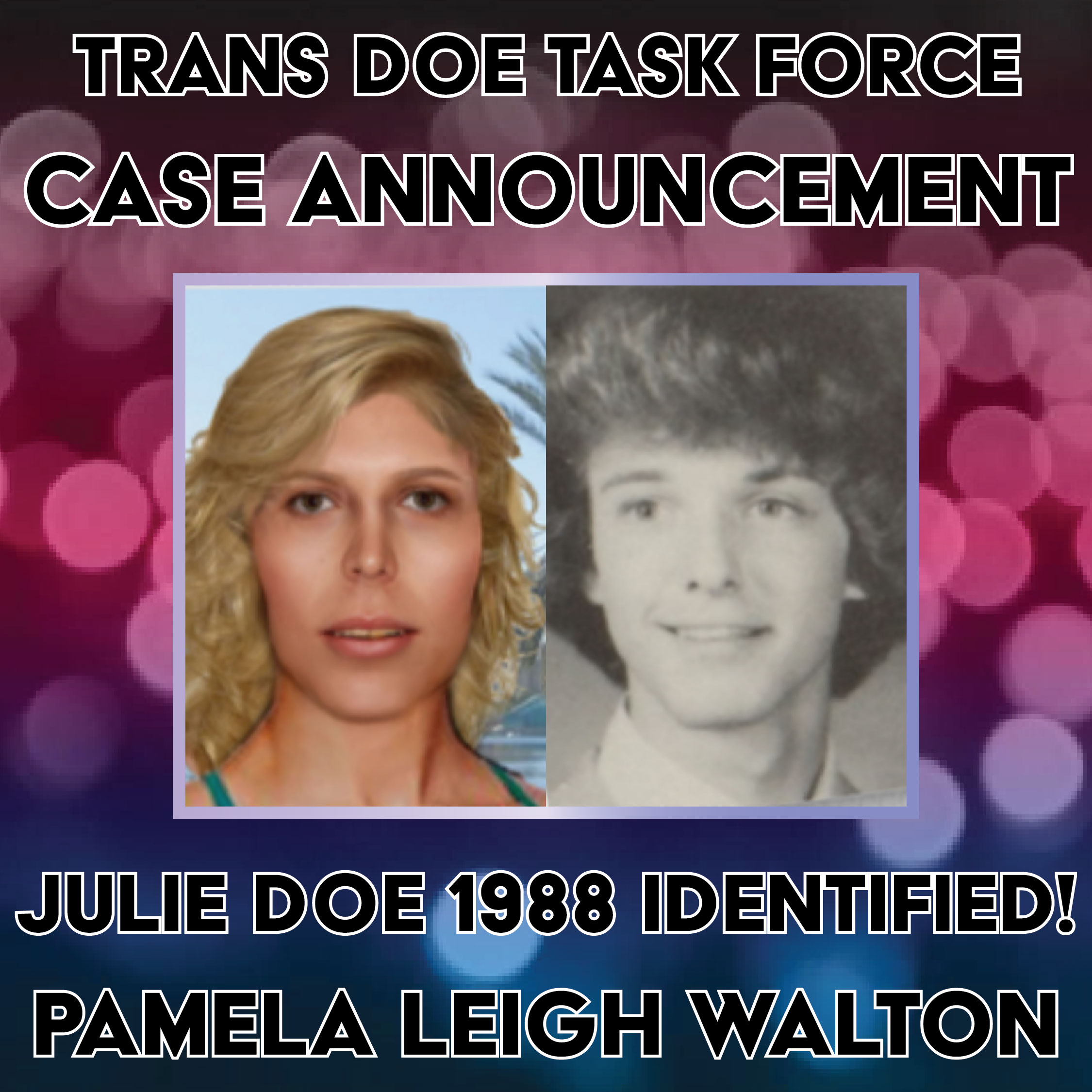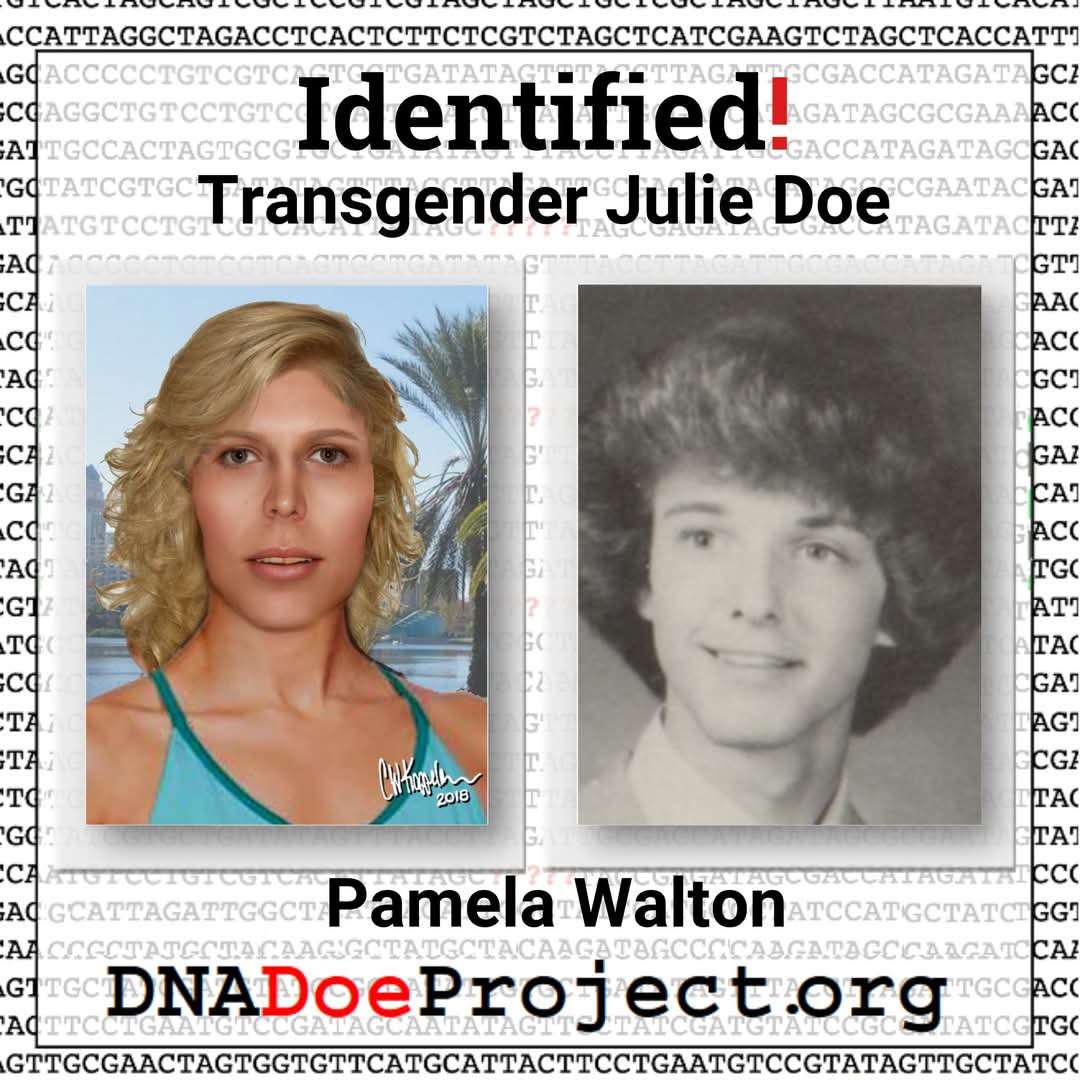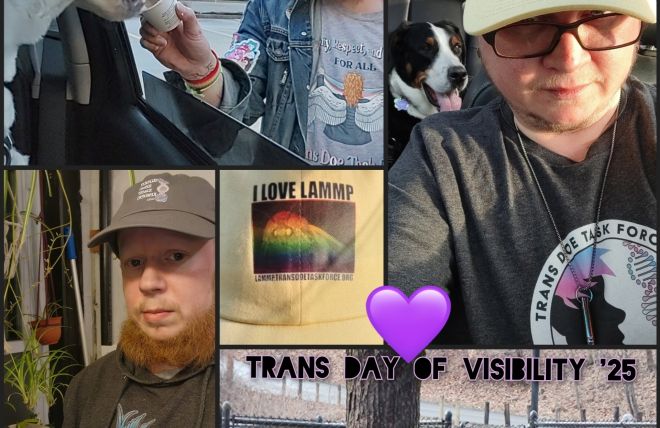
Most of you who know of our work are familiar with the case of Julie Doe. We are happy and relieved to be able to share that she finally has her name back: Pamela Leigh Walton. We have been working on her case in one form or another for the past seven years. Massive thanks to the persistence of the DNA Doe Project team who diligently worked on her genetic genealogy after we (Lee and Anthony Redgrave) left to incorporate the Trans Doe Task Force. After so many months of working to get her case through DNA labs to get a workable genealogy kit to upload, having a new forensic image created for her by Carl Koppelman, and then case launch and initial genetic genealogical research- leaving her case behind was incredibly difficult for us. We are overwhelmed with emotions and gratitude that we are finally able to say her name.
We also need to advise a content warning for anyone who goes to read external news articles beyond what we and the DDP are publishing; some news outlets are using her deadname and incorrect pronouns. We would like to encourage journalists wishing to report on this case to reach out to us for free consultation about how to respectfully report on Trans homicide victims.
This case remains unresolved, and having her name back is the best new information her case could receive. Hopefully, anyone who knew her or knows about the crime may come forward. If you have information and would like to contact investigators, please reach out the Lake County Sheriff's Office. If you are a member of the LGBTQ+ community and knew Pamela but are uncomfortable contacting law enforcement, please email us and we would be happy to help. We have no further information on any memorials which may occur, but are able to provide digital memorial space for friends and chosen family if desired. If anyone has any more recent photos of Pamela, please consider sharing them. Thank you to everyone who contributed to this case over the years, from investigators to students to genealogists to supporters who donated to the lab costs- everyone played an invaluable role in this incredible identification story.
Social media post via the DNA Doe Project:
"It is an honor to say her name - Pamela Walton."
More than 36 years after her murder, DNA Doe Project investigative genetic genealogists have overcome numerous brick walls to identify the woman previously known as Transgender Julie. Read the full press release here:
https://dnadoeproject.org/case/transgender-julie-doe/
We thank all 46 of the volunteers who have worked on this case over the years, and our friends at Trans Doe Task Force.

Press release via DNA Doe Project:
Jane Doe Identified after 36 years
DNA Doe Project Identifies Transgender Woman
Orlando, FL - On September 25, 1988 a passerby looking for cypress wood to build lawn furniture discovered the body of a woman in a wooded area in the vicinity of Hwy 474 west of Orlando, Florida. Authorities at the time suspected she had been sexually assaulted and murdered. She became known as Julie Doe. After more than 36 years, Pamela Leigh Walton has been identified through investigative genetic genealogy by the DNA Doe Project.
Her initial autopsy in 1988 discovered she had healed fractures of her cheekbone and nose, along with a rib. She had breast implants that dated from before 1985. This autopsy concluded that she was female, and had given birth to at least one child. Later DNA testing revealed that she had been born biologically male, with both X and Y chromosomes.
In 2019, the Lake County Sheriff’s Office reached out to the DNA Doe Project to try a novel technique - investigative genetic genealogy - to find her identity. They connected with volunteers who were also part of an initiative called the Trans Doe Task Force, who began the work on the case before leaving to focus full time on that group. It would take five years of diligence and persistence by a team of expert volunteers to narrow Pamela’s family tree to the correct branch to find her name.
“The team faced just about every possible hurdle, from unknown parentage, matches who were adopted, to endogamy,” said team co-leader Eric Hendershott. “Even up to the end, when we suspected that she was adopted, the team was stuck.”
Adoption records are not accessible to genetic genealogists, and adoption presents a brick wall to investigators because the child is often removed from their community of birth and their name is changed. Pamela had been adopted at the age of 5, which left a few breadcrumbs for researchers to follow.
“It was clear from the start that our Doe had strong family ties to Kentucky, but we didn't know for sure if she was born there or if she ever lived there,” said Lance Daly, investigative genetic genealogist. “While searching Fayette County records, we discovered the names of two key relatives who were crucial to unraveling the mystery.”
Pamela had grown up with her adopted family in Kentucky, and had officially changed her name before she was in her mid-20s, likely around the time she underwent sex reassignment surgery and therapy.
“Pamela’s story includes many common themes that trans people face,” said Pam Lauritzen, Executive Director of Media and Communications. “From derogatory notations left in high school yearbooks about her to a headstone pre-carved with her former male name, it’s heartbreaking to know that the community was not willing to accept her and the identity she chose.”
In 2024, DNA Doe Project conducted a media outreach campaign to try to get tips from the public who might have known the then Julie Doe. Facebook posts boosted into Kentucky and Florida received multiple reports as “misleading” and “spam”, causing Meta to remove the posts and cancel the ads before they could run. After review, the posts were reinstated, only to be removed again after a few hours.
“This went on for weeks,” Lauritzen explained. “The support person acknowledged that it was because we were boosting a transgender case into places where anti-trans sentiment runs high. Eventually, Meta just stopped responding to my requests for review.”
Julie Doe’s story was featured in a handful of publications, but in the end it was genealogy research that resolved the case.
“Pamela Walton’s identification is the result of over five years of work by nearly 50 volunteers,” said Emily Bill, investigative genetic genealogist. “Their efforts laid the foundation for a series of recent discoveries that finally led us to her name.”
The DNA Doe Project is grateful to the groups and individuals who helped solve this case: the Lake County Sheriff’s Office, who entrusted the case to the DNA Doe Project; The Trans Doe Taskforce for bringing the case to DDP; University of North Texas Center for Human Identification for extraction of DNA and sample prep for whole-genome sequencing; HudsonAlpha Discovery for sequencing; Greg Magoon for bioinformatics; GEDmatch Pro and FTDNA for providing their databases; our generous donors who joined our mission and contributed to this case; and DDP’s dedicated teams of volunteer investigative genetic genealogists who work tirelessly to bring all our Jane and John Does home.
News articles about Pamela Leigh Watson:





